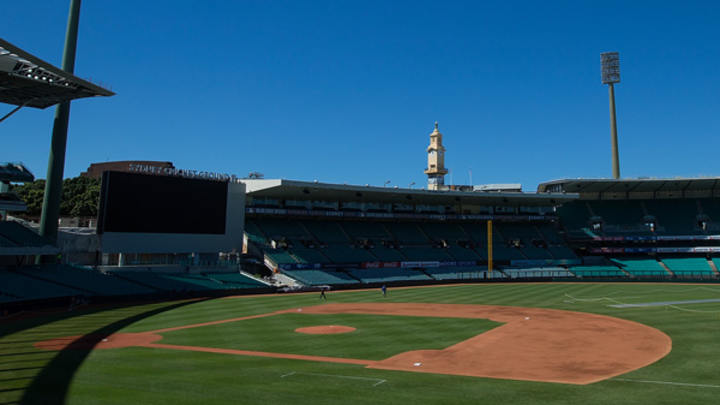Watch: MLB reinvents historic Sydney Cricket Ground for Opening Day baseball

A general view of SCG ahead of the Opening Series at Sydney Cricket Ground. (Joosep Martinson/Getty Images)

Don’t mind the nearly 7,000 tons of warning track mix, sod, infield clay and other materials brought in to turn the historic Sydney Cricket Ground into MLB’s Opening Day event. MLB field coordinator Murray Cook kept every ounce of that material away from the field’s treasured area: The center pitch.
"You can’t touch the center," Cook told SI.com from Sydney. "There is a lot of heritage and culture, and it is hollowed ground."
But Cook’s crew had to touch plenty else to get the stadium, established in the mid-1800s and with stands still in use from the 1870s, ready to host a two-game set between the Dodgers and Diamondbacks. And they had to do it all in 16 days.
[mlbvideo id="31565453" width="600" height="336" /]
"Building a ballpark in a few days takes a lot of planning," Cook says. “Sixteen months of planning beforehand."
The baseball field orientates with home plate in front of a brand-new $170 million grandstand. But after more than 150 years of cricket (including a baseball game between New South Wales and the Chicago White Sox in 1914), the area inside the oval stadium wasn’t completely level. Last October, crews removed grass—not from the center pitch, which will sit in shallow center field—to level off the field, fixing “slopes that were kind of off.”
The team then went shopping, looking for baseball-styled material. They loaded in root-zone mix and sod to build the infield and found 600 tons of "phenomenal" local terracotta for the warning track. But they weren’t happy with the clay mixture, instead bringing in 200 tons of clay to Sydney Harbour from San Diego to help amend the infield and pitcher’s mound.
(Courtesy of Murray Cook)

With such a large, oval stadium, Cook needed to create a regulation fence. But the Sydney Cricket Ground won’t allow holes deeper than eight inches. Cue up engineers devising a counter-balance system to hold the fence and foul poles in place. Suspending 150 tons of concrete blocks will hold the eight-foot-tall fences for the outfield and sides, even if a player runs into it at full speed. Concrete counter balances also hold up the 45-foot-tall foul poles, located 328 feet down the lines.
With all that extra space between the fencing and the stands, MLB has created party areas with covered decks, bringing the expected crowds to about 45,000.
While looking around from on the field, Cook said the huge contrast between the new stands and the Victorian architecture of the heritage 1800s building right next to it actually marry up because of the country’s longtime love for cricket. And their even deeper respect for the actual cricket square—grass mixed with clay, which will play a littler firmer with the ball scooting a touch faster—left one area of the Sydney Cricket Grounds untouched by the MLB makeover. Just the like the stands nearby, it's a marriage of modern and heritage.
Tim Newcomb covers stadiums, design and gear for Sports Illustrated. Follow him on Twitter at @tdnewcomb.
